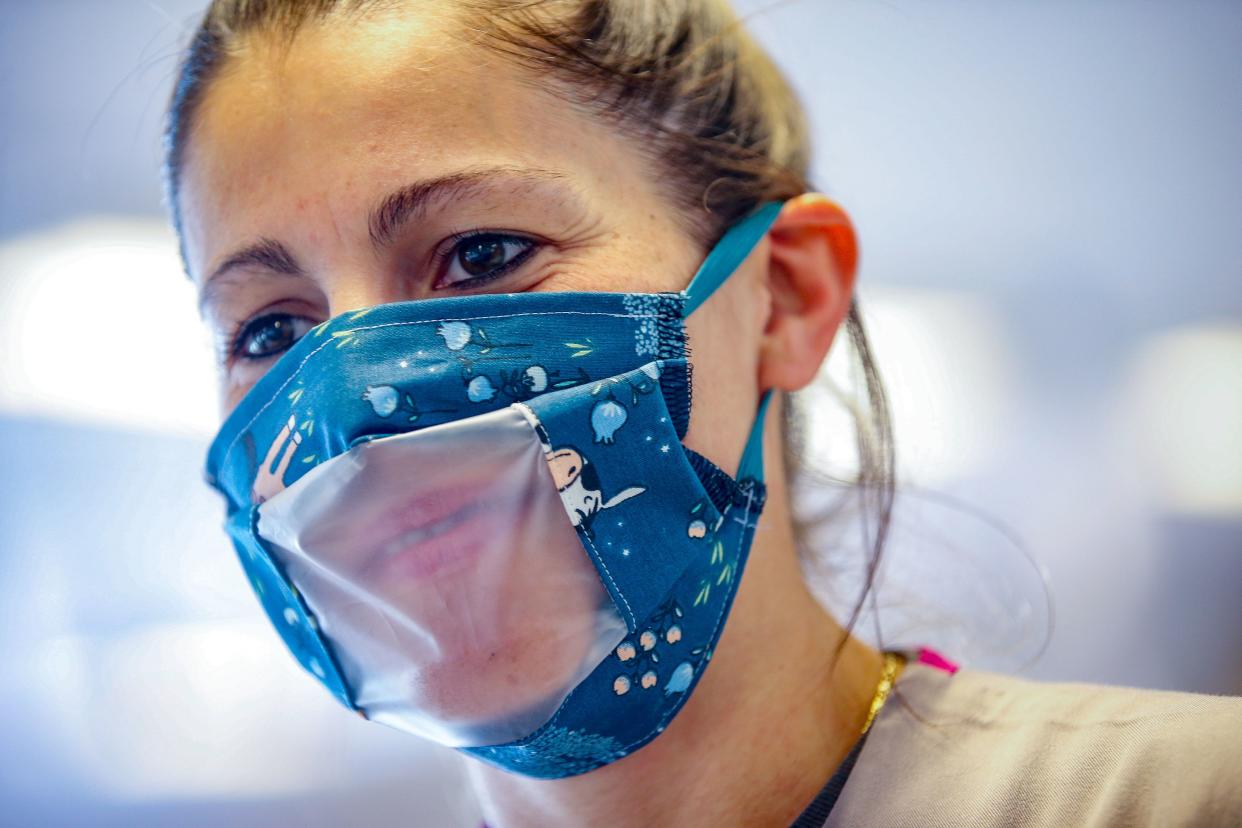Are clear masks the way to clearer communication? The deaf community isn't so sure.

The precautions put in place to contain the coronavirus have created obstacles for many. But for the deaf community, it’s been a particularly harrowing battle. On top of the noticeable absence of sign language interpreters to communicate developments in the crisis, those with hearing loss who communicate through lip-reading have had to contend with the use of masks, which obstruct their ability to do so.
In recent weeks, the movement to switch to masks that are either partially or fully transparent — in hopes to alleviate one aspect of this struggle — has been growing. There are countless iterations of this appearing online: a transparent surgical mask (called the ClearMask); masks with clear windows being sewn by a college student in Kentucky; and even do-it-yourself templates posted online.
a college student studying education for the deaf and hard of hearing has designed a face mask with a clear window that allows others to see and read lips and facial expressions https://t.co/GO23cIowv3 pic.twitter.com/S6Jtb8ybrX
— designboom (@designboom) April 9, 2020
The clear masks, it seems, are a solid step towards inclusivity. But for many in the deaf community, they’re not quite the perfect solution that they seem. Sarah Katz, a deaf writer whose work has appeared in the New York Times among other places, says that their arrival — three months into a global pandemic — is indicative of the inequalities that her community faces regularly.
“As the devastation of Hurricane Katrina and many other disasters have made clear, disabled people are routinely excluded from disaster preparedness plans,” Katz tells Yahoo Life. “Clear masks should have been made available a long time ago. Opaque masks have been a barrier not only during this public health crisis but also in regular health care situations. The current crisis has just expanded the number of situations in which masks are an accessibility barrier.”
Shannon McCracken, a spokesperson for ANCOR, a nonprofit focused on accessibility for the disabled, agrees. “We certainly are seeing the pitfalls of creating one-size-fits-all guidance around the use of masks and other PPE, as those approaches tend not to consider the unique needs and challenges of people with disabilities,” McCracken tells Yahoo Life.
A college classmate of mine who is deaf (@allysadittmar) helped create a clear surgical mask after terrible experiences in the hospital being sick but unable to read anyone's lips because of the masks.
She founded @the_clearmask -- I hope to see it become widespread reality! pic.twitter.com/1ZwKoerWaJ— DoctorJohn (@DoctorJohn_MD) April 25, 2020
On top of the delay in creating them, Katz and others in the deaf community have also expressed concern about clear masks’ functionality. “Many complain that clear masks fog up, which is a design flaw that should be remedied,” says Katz. “I do think there's room for improvement in clear masks, though.”
Paulo Martell, a program coordinator at the National Children’s Center (NCC) — a D.C.-based nonprofit dedicated to providing support to infants, kids and adults with disabilities — is not overly optimistic about the clear masks, either. “I would not recommend it for an effective way to facilitate communication,” Martell, who is deaf himself, tells Yahoo Life. “Even an expert lip reader still can only catch half or less of what this person is saying. We often fill in the blanks with guesses [on] the content of this time discussed.”
Instead, Martell — and many other deaf advocates online — are recommending that individuals consider devoting time to making every day life more inclusive. “There might be one way to prevent conflicts and facilitate communication better is to learn sign language,” says Martell. “Sign language is a universal language. A droplet of fluid from our mouth while speaking can travel from one person to other person and sign language doesn't therefore it’s a safer [way] to communicate via sign language than it is to speak.”
In a thread on Twitter, UK musician and deaf awareness advocate Eloise Garland expanded on this, noting that lip reading in the best case scenario is only “30 percent effective” and that with clear masks’ potential to fog up, this would be further reduced. Garland instead encourages individuals to use this moment to think about inclusive communication as a whole. “[Do] you know what else would be REALLY helpful to many deaf people?” Garland tweeted. “Learning some BSL [British sign language]. If this is going to be our 'new normal' then personally I'd rather people learn how to communicate visually.”
The exact number of sign language users in the U.S. is difficult to pinpoint, but experts estimate that anywhere from 250,000 to 500,000 individuals (or perhaps even millions) rely on what’s known as ASL or American Sign Language. Many online resources provide an entryway into this language, and encourage even those with full hearing capabilities to familiarize themselves with the language.
For Katz and others, the clear mask may not be a perfect solution. But she seems hopeful that the development may signal a move towards inclusivity. “It's an important step in the right direction,” she says.
For the latest coronavirus news and updates, follow along at https://news.yahoo.com/coronavirus. According to experts, people over 60 and those who are immunocompromised continue to be the most at risk. If you have questions, please reference the CDC’s and WHO’s resource guides.
How to maintain your physical and mental health during the pandemic
Taking care of a loved one with COVID-19? Here’s how to stay healthy
Q&A with Dr. Kavita Patel: How to keep your family safe and maintain your mental health
Read more from Yahoo Life:
Want daily lifestyle and wellness news delivered to your inbox? Sign up here for Yahoo Life’s newsletter.


